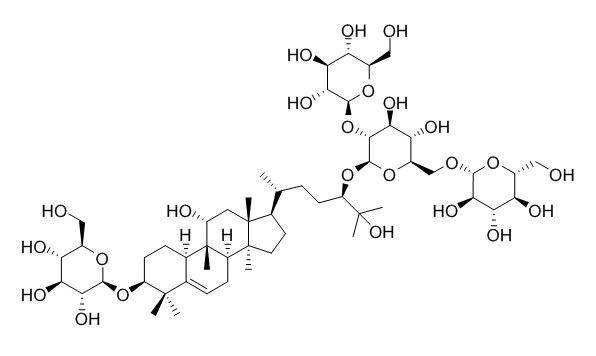Siamenoside I
Siamenoside I is one of the mogrosides that has several kinds of bioactivities, it exhibits maltase inhibitory effect with the IC50 value of 12 mM.
Inquire / Order:
manager@chemfaces.com
Technical Inquiries:
service@chemfaces.com
Tel:
+86-27-84237783
Fax:
+86-27-84254680
Address:
1 Building, No. 83, CheCheng Rd., Wuhan Economic and Technological Development Zone, Wuhan, Hubei 430056, PRC
Providing storage is as stated on the product vial and the vial is kept tightly sealed, the product can be stored for up to
24 months(2-8C).
Wherever possible, you should prepare and use solutions on the same day. However, if you need to make up stock solutions in advance, we recommend that you store the solution as aliquots in tightly sealed vials at -20C. Generally, these will be useable for up to two weeks. Before use, and prior to opening the vial we recommend that you allow your product to equilibrate to room temperature for at least 1 hour.
Need more advice on solubility, usage and handling? Please email to: service@chemfaces.com
The packaging of the product may have turned upside down during transportation, resulting in the natural compounds adhering to the neck or cap of the vial. take the vial out of its packaging and gently shake to let the compounds fall to the bottom of the vial. for liquid products, centrifuge at 200-500 RPM to gather the liquid at the bottom of the vial. try to avoid loss or contamination during handling.
Sci Rep.2016, 6:25094
J Ethnopharmacol.2024, 318(Pt B):116961.
Nutrients.2023, 15(6):1417.
Turkish Journal of Pharmaceutical Sciences2022, DOI: 10.4274
Current Traditional Medicine, 2021, 7:326-335(10).
Front Microbiol.2022, 12:833233.
Antiviral Res.2021, 193:105142.
SCOPUS.2020, 836-847.
Int J Mol Sci.2020, 21(9):3392.
bioRxiv2021, 462065.
Related and Featured Products
J Atheroscler Thromb. 2002;9(2):114-20.
Sweet elements of Siraitia grosvenori inhibit oxidative modification of low-density lipoprotein.[Pubmed:
12236315]
This study examined the ability of sweet elements extracted from Siraitia grosvenori (SG) to inhibit the oxidation of LDL.
METHODS AND RESULTS:
We monitored the formation of conjugated diene during copper-mediated LDL oxidation in the presence or absence of sweet elements of whole extract of SG (SG extract) or cucurbitane glycosides (CGs) purified from SG extract as sweet elements. CGs consist of Mogroside IV (Mog.IV), Mogroside V (Mog.V), 11-Oxo-mogroside V (11-Oxo-mog.V), and Siamenoside I (Sia.I). In addition, the effect of these elements on human umbilical vein endothelial cell (HUVEC)- mediated LDL oxidation was tested by measuring production of lipid peroxides. SG extract inhibited copper-mediated LDL oxidation in a dose-dependent fashion, but neither glucose nor erythritol suppressed the oxidation. Among CGs, 11-Oxo-mog.V significantly inhibited LDL oxidation, and prolongation of the lag time during LDL oxidation by 11-Oxo-mog.V was dose-dependent. The lag time (119.7 +/- 8.9 min) in the presence of 200 microM 11-Oxo-mog.V was significantly longer than that (76.8 +/- 5.5 min) of control (p < 0.01). In addition, SG extract and 11-Oxo-mog.V inhibited HUVEC-mediated LDL oxidation in a dose-dependent manner.
CONCLUSIONS:
These results demonstrate that SG extract can inhibit LDL oxidation and that 11-Oxo-mog.V, a sweet element of SG extract, provides the anti-oxidative property of SG which might reduce the atherogenic potential of LDL.
J Agric Food Chem. 2005 Apr 20;53(8):2941-6.
Triterpene glycosides of Siraitia grosvenori inhibit rat intestinal maltase and suppress the rise in blood glucose level after a single oral administration of maltose in rats.[Pubmed:
15826043]
The effect of the crude extract from Siraitia grosvenori Swingle (SG-ex) on the postprandial rise in blood glucose level was investigated.
METHODS AND RESULTS:
The increase in plasma glucose level in response to the oral administration of maltose was significantly suppressed in rats when SG-ex was given orally 3 min before the maltose administration. There was, however, no effect when glucose was administered instead, suggesting that the antihyperglycemic effect of SG-ex is elicited by inhibition of maltase in the small intestinal epithelium. In vitro, SG-ex inhibited rat small intestinal maltase. Similar effects were also observed both in vivo and in vitro when the concentrate of the sweet elements (triterpene glycosides) prepared from SG-ex was used. Furthermore, the main sweet element of SG-ex, mogroside V, and some minor elements such as mogroside IV, Siamenoside I, and mogroside III also exhibited maltase inhibitory effect with IC50 values of 14, 12, 10, and 1.6 mM, respectively.
CONCLUSIONS:
These results suggest that SG-ex exerts anti-hyperglycemic effects in rats by inhibiting maltase activity and that these effects are at least partially exerted by its sweet elements, triterpene glycosides.



